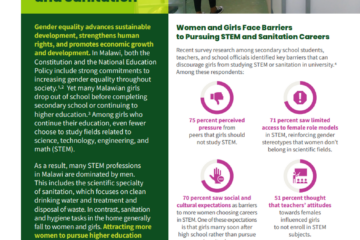
How Many Men Have HPV?
Date
May 20, 2011
Focus Areas
Half of men ages 18 to 70 who participated in a study of genital human papillomavirus (HPV) in Brazil, Mexico, and the United States were infected with some form of the virus, according to the “HPV in Men” (HIM) study recently published in The Lancet.1 Anna Giuliano, of the H. Lee Moffitt Cancer Center, and her colleagues screened 4,074 men from the general population, universities, and organized health care systems in southern Florida; Sao Paulo, Brazil; and Cuernavaca, Mexico. The researchers studied the natural history of HPV infections to get a snapshot of how they affect men.
HPV is a group of more than 150 types of related viruses—of which more than 40 are sexually transmitted and can be spread very easily through genital contact with another person.2 Genital HPV is the most common sexually transmitted infection in the United States, currently affecting about 20 million Americans.3 According to the U.S. Centers for Disease Control and Prevention, HPV is so common that at least half of sexually active men and women get it at some point in their lives. But only one type, HPV-16, causes cancer in men, said Giuliano in an interview with NPR on March 4, 2011.4
Giuliano’s study reports on the first 1,159 men who participated in the study. At the time of enrollment, 50 percent of men were infected with genital HPV. “We were actually detecting 37 different types of HPV occurring—that could occur in men at the external genital skin. And we followed men prospectively so we could actually look at the rate at which men acquire these new infections, and the rate at which these infections are cleared,” she told NPR. She emphasized in the interview that the study was “a summary measure of all HPV types that were detected”—only some of the 37 HPV types cause cancer.
Different Types of Genital HPV
Some genital HPVs are high-risk, causing cancer and other diseases; others are low-risk, for example, those causing genital warts.5 About 15 high-risk viruses are factors in cancer of the cervix, vulva, vagina, anus, and head and neck in women; and contributors to cancers of the penis, anus, and head and neck in men (see Table 1). HPV infection accounts for 5 percent of all cancers worldwide. HPV-16 and HPV-18 together are linked to about 70 percent of cervical cancers. There is no simple screening to find HPV in men and no effective screening for noncervical cancers in men and women.6
Table 1
HPV-Related Cancer and Disease in the U.S.
| HPV-Type Most Attributed | Average Number of Men Affected Yearly | Average Number of Women Affected Yearly | |
|---|---|---|---|
| Anal Cancer | 16 | 1,100 (2010) | 2,700 (2009) |
| Cervical Cancer | 16 & 18 | n/a | 11,000 (2011) |
| Genital Warts | 6,11 | 1 in 100* (2011) | 1 in 100* (2011) |
| Head and Neck Cancers | 16 | 5,700 (2010) | 2,300 (2009) |
| Penile Cancer | 16 | 800 (2010) | n/a |
| Vaginal Cancer | 16 & 18 | n/a | 1,000 (2009) |
| Vulvar Cancer | 16 & 18 | n/a | 3,700 (2009) |
Note: *Of sexually active adults.
Sources: Centers for Disease Control (CDC), Genital HPV Infection Fact Sheet, Nov. 24, 2009, accessed at www.cdc.gov, on March 8, 2011; CDC, HPV and Men Fact Sheet, October 14, 2010, accessed at www.cdc.gov, on March 8, 2011; CDC, “HPV Vaccine: Questions and Answers” (April 6, 2011), accessed at www.cdc.gov/vaccines/vpd-vac/hpv/vac-faqs.htm, on May 16, 2011; Gypsyamber D’Souza et al., “Case-Control Study of Human Papillomavirus and Oropharyngeal Cancer,” The New England Journal of Medicine, May 10, 2007, accessed at www.nejm.org, on March 16, 2011; Maura L. Gillison, Anil K. Chaturvedi, and Douglas R. Lowy, “HPV Prophylactic Vaccines and the Potential Prevention of Noncervical Cancers in Both Men and Women,” Supplement to Cancer, Nov. 3, 2008, accessed at www.interscience.wiley.com, on March 18, 2011; Anna R. Giuliano et al., “Incidence and Clearance of Genital Human Papillomavirus Infection in Men (HIM): A Cohort Study,” The Lancet, March 1, 2011, accessed at www.thelancet.com, on March 7, 2011; and National Cancer Institute, Human Papillomaviruses and Cancer Fact Sheet, Dec. 13, 2010, accessed at www.cancer.gov, on March 14, 2011.
Men Clear HPV Infections Slower Than Women
HPV is a silent infection. Most people infected with HPV show no symptoms and can unknowingly transmit the virus to their sexual partners.7 In 90 percent of cases, the body’s immune system clears the infection on its own within two years. In the HIM study group, new HPV infections took an average of 7.5 months to clear (see Table 2). Men ages 18 to 30 require significantly longer than other age groups to clear any type of HPV infection—a phenomenon strongly associated with sexual behavior with female and male sexual partners. While women’s risk of HPV decreases with age, men appear to be at high risk of acquiring new HPV infections throughout their lives.
Table 2
HPV Infection in Men Ages 18-70, 2009
| % Prevalence | |
|---|---|
| Any HPV | 50 |
| Cancer-causing | 30 |
| HPV-16 | 6 |
| HPV-18 | 2 |
| Other | 38 |
| HPV-6 | 7 |
| HPV-11 | 1 |
Source: Anna R. Giuliano et al., “Incidence and Clearance of Genital Human Papillomavirus Infection in Men (HIM): A Cohort Study,” The Lancet, March 1, 2011, accessed at http://www.thelancet.com, on March 7, 2011.
HPV Infection Can Be Prevented but not Cured
As with other sexually transmitted infections, the risk of getting or transmitting an HPV infection can be significantly reduced by always using a condom. In 2006, the FDA approved vaccines to protect girls and young women from being infected with common types of HPV. Gardasil and Cervarix protect against cancer-causing types 16 and 18, while Gardasil also protects against types 6 and 11 which cause genital warts. These vaccines lessen the risk of new infections; they do not cure existing ones.
While Gardasil has also been approved for boys and men ages 9 through 26, the vaccine is not on the CDC’s recommended immunization schedule for males in this age group. The reason: Studies suggest that the best way to prevent the most HPV-related disease is by vaccinating as many girls and women as possible.8 As of 2009, 17 percent of women ages 19 to 26 had received at least one dose of HPV vaccination. Among boys ages 11 to 17, less than 1 percent have been vaccinated, but the share of vaccinated men on college campuses is around 15 percent.9
While genital warts are not a health threat and do not lead to cancer, Dr. James C. Turner, a liaison to the government’s Advisory Committee on Immunization Practices, indicates that they are more than just a nuisance for those affected: “I would say that the men that I see would rate genital warts on the quality scale just above death,” Turner noted in a New York Times article.10
References
- Anna R. Giuliano et al., “Incidence and Clearance of Genital Human Papillomavirus Infection in Men (HIM): A Cohort Study,” The Lancet, March 1, 2011, accessed at www.thelancet.com, on March 7, 2011.
- National Cancer Institute, Human Papillomaviruses and Cancer Fact Sheet, Dec. 13, 2010, accessed at www.cancer.gov, on March 14, 2011.
- Centers for Disease Control (CDC), Genital HPV Infection Fact Sheet, Nov. 24, 2009, accessed at www.cdc.gov, on March 8, 2011.
- NPR, “Human Papillomavirus Infection and Cancer Risk” (March 4, 2011), accessed at www.npr.org, on March 7, 2011.
- American Cancer Society, “What Is HPV?” (Jan. 3, 2011), accessed at www.cancer.org, on March 18, 2011.
- CDC, HPV and Men Fact Sheet, October 14, 2010, accessed at www.cdc.gov, on March 8, 2011; and Maura L. Gillison, Anil K. Chaturvedi, and Douglas R. Lowy, “HPV Prophylactic Vaccines and the Potential Prevention of Noncervical Cancers in Both Men and Women,” Supplement to Cancer, Nov. 3, 2008, accessed at www.interscience.wiley.com, on March 18, 2011.
- CDC, HPV and Men Fact Sheet, October 14, 2010, accessed at www.cdc.gov, on March 8, 2011.
- CDC, “HPV Vaccine: Questions and Answers” (April 6, 2011), accessed at www.cdc.gov/vaccines/vpd-vac/hpv/vac-faqs.htm, on May 16, 2011.
- Gardiner Harris, “U.S. Panel Debates Value of HPV Vaccine for Boys” (Oct. 28, 2010), accessed at www.nytimes.com/2010/10/29/us/29vaccine.html, on March 7, 2011.
- CDC, “2009 Adult Vaccination Coverage, NHIS” (March 2, 2011), accessed at www.cdc.gov/vaccines/stats-surv/nhis/2009-nhis.htm, on May 16, 2011.





